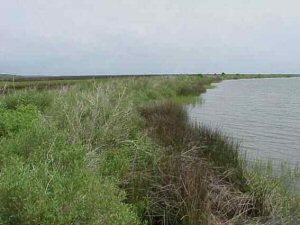- Strengthen efforts to secure adequate freshwater inflows.
- Increase capacity for studying coastal ecosystems
Tidal Streams
Texas Parks and Wildlife Department personnel, under contract with Texas Commission on Environmental Quality (TCEQ) have been studying tidal streams for several years.

Tidal Streams are highly productive transitional areas between the freshwater of the rivers and the increased salinities found in the estuary. These tidal streams also serve as important nursery areas for many fish and shellfish species, including many of the same recreationally or commercially important species found in the estuary.
The high primary producivity found within estuaries is generally associated with nutrient loadings via freshwater inputs and overall productivity is maintained by complexes of emergent vegetation, benthic algae, and phytoplankton, which can all efficiently utilize the nutrients.
Routine monitoring of several tidally influenced streams throughout the State of Texas have revealed that water quality standards are not being met, as dissolved oxygen measurements in the tidal segments are routinely lower than the established criteria. Water quality management of these areas has been difficult because currently there are no state-wide criteria for assessing tidally influenced waterbodies, and these systems are naturally quite variable over time and space.
Phase I of the Tidal Stream project, which was completed in 2007, developed a standardized methodology for assessing ecosystem health and assigning site-specific uses and criteria within tidally influenced portions of streams. The streams which were studied are; Cow Bayou Tidal (orange County), Tres Palacios River Tidal (Matagorda County), and Garcitas Creek Tidal (Jackson and Victoria Counties); those streams were compared to reference streams which were meeting the dissolved oxygen criteria, lost River (Jefferson County) and West Crarancahua Creek (Jackson County).
Phase II of the study furthered this new methodology, which relies heavily on multivariate ordination techniques. For the present study, the tidal portions of Mission and Aransas Rivers (San Patricio and Refugio Counties) were assessed with this same multivariate methodology, with the Mission River serving as the presumptive reference condition.
The final reports, historical data reviews and QAPP can be found on the TCEQ tidal streams webpage.
For more information on the project and documents available for review,
please contact:
James Tolan, Ph.D. 361-825-3247